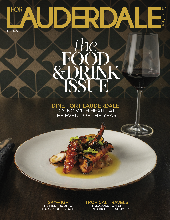
Fort Lauderdale history is filled with remarkable women pioneers: women such as Ivy Stranahan, teacher, civic leader, suffragist and decades-long activist for the rights of Seminoles. Or Sylvia Aldridge, African-American trailblazer, who built businesses and helped fund such institutions as Provident Hospital and Dillard High School.
But perhaps the woman who was earliest to make a mark where we now live is one who figured in centuries-old accounts by Spanish colonizers. And her name appears in one of the strangest titles ever for a large tract of land.
You’ve heard of the Louisiana Purchase. But have you heard of the “Frankee Lewis Donation”? At a time in history (the late 1700s and early 1800s) when most figures written about were men, who was this woman?
Texts from the era before Spain ceded Florida to the U.S. in 1825 refer to a couple from the Bahamas, Charles (“Surles”) Lewis and his wife, Frankee, who settled on the New River. This was long before non-native settlers such as the Cooleys and the Stranahans.
The Lewises and their three children were indeed the area’s first permanent non-native residents, clearing land for a farm in 1792 and growing oranges, lemons, limes and guava. It was tough going, says historian Stuart McIver.
“They had to go all the way to St. Augustine to find a town. It was a pretty scarce world,” McIver told the Sun-Sentinel in a 2007 interview. “Whatever they had to sell from their farm they marketed over in the Bahamas.”
Tragically, Charles Lewis and his oldest son drowned in a hurricane during a Bahamas trip in 1819.
Frankee could of course have packed up and left, heading back to civilization. But instead she persevered, even boosting the successful production of their coontie crop. They learned to harvest coontie root for flour, most likely from the Seminoles.
As more and more tracts of South Florida were bought in absentia by wealthy landowners from the north (such as the Brickells, who would found Miami), Frankee must have felt a need to legitimize her claim to land. So, according to McIver, she applied to Spain for a land grant.
Now, let’s stop right there. A farmer in an unsettled riverbank area writes to the top levels of the government, possibly the King of Spain? First, women had just about no rights in those days, including the right to own land. Second, as Spain was no doubt figuring out how to extricate itself from Florida, why should an official in Spain bother responding?
And then there was the matter of her late husband’s association with a major thorn in the country’s side, a renegade British soldier named William Augustus Bowles. The Englishman had mobilized a revolutionary army of Seminoles, Creeks and former Spanish slaves to establish the territory of Florida as an Indian nation.
In a 1793 report prepared for the Spanish colonial governor of Florida, Juan Nepomuceno de Quesada, the alarm was sounded about Bowles. A search for Bowles uncovered the Lewis home, a small wooden house on a pine bluff on the New River. Quesada, hearing that the Lewis home had been given to them by Bowles, recommended that the Lewises be imprisoned.
But the king, Charles IV, decided to set aside the Lewis matter, having greater problems then with France.
And now, years later, the man’s widow was asking him to legitimize her land? What kind of a persuasive letter or proposal must that have been?
Unfortunately, there seems to be no copy of it. Yet against all odds, Spain awarded her a land grant for 640 acres of prime farmland on the New River, about a mile from the ocean. The land grants given by Spain then were called “donations.” Thus, the Frankee Lewis Donation. The U.S. later ratified the agreement.
The Broward County Historical Commission, which says there is no trace of the original homestead, has erected a memorial telling the story of the Lewises. It’s in a small park called Lewis Landing, beside the New River on SW Ninth Avenue in the Tarpon Bend neighborhood.
Several years after the “donation,” Frankee Lewis sold her land for a handsome profit and moved on to Miami. As for the donation, it soon came into the hands of another significant woman in South Florida history, Mary Brickell. But that’s a column for another day.











